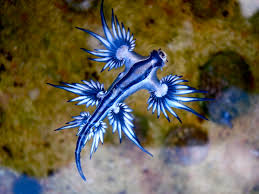
Introduction to the Blue Dragon Sea Slug
The blue dragon sea slug, scientifically known as Glaucus atlanticus, is a striking marine creature that has captured the interest of both scientists and ocean enthusiasts alike. Known for its vivid blue coloration and intriguing behaviours, this tiny mollusc is not only a beauty but plays an essential role in the marine ecosystem. As climate change and ocean health become increasingly pressing issues, understanding such unique organisms is crucial for marine conservation.
Physical Characteristics
The blue dragon typically measures only about 3 centimetres in length. Its unique coloration is a result of a combination of its diet and its ability to absorb and mimic the toxins of other marine organisms it consumes, such as the Portuguese man o’ war. This not only serves as a warning to potential predators but enhances the slug’s survival chances. The blue dragon’s body is elongated and features six pairs of cerata, which are finger-like projections that help with respiration and buoyancy.
Habitat and Behaviour
This fascinating sea slug is predominantly found in warm, tropical waters, often drifting in the ocean currents. It is commonly spotted in the southern and eastern coasts of South Africa, California, and Australia. The blue dragon is a pelagic creature, meaning it spends most of its life floating on the ocean surface. It uses its dorsal fin to propel itself through the water, and its diet mainly consists of small jellyfish and other colonial organisms. The slug’s unique method of locomotion and hunting tactics are an embodiment of nature’s adaptability.
Ecological Significance
The blue dragon sea slug plays a crucial role in its habitat. By feeding on jellyfish, it helps maintain the balance of the marine ecosystems it inhabits. Additionally, its ability to accumulate the stinging cells of its prey allows it to defend itself against predators, showcasing a remarkable example of evolutionary biology. The blue dragon contributes to the complexity and interconnectedness of marine life, emphasising the importance of conservation efforts for healthy ocean environments.
Conclusion and Conservation
As climate change and pollution pose ongoing threats to marine biodiversity, understanding the existence and role of organisms like the blue dragon sea slug is vital. Protecting marine habitats ensures the preservation not only of this species but of the myriad of life forms that rely on ocean health. For enthusiasts, scientists, and anyone curious about the wonders of the sea, the blue dragon sea slug serves as a beautiful reminder of the complexity and fragility of our oceans. Future research and conservation initiatives will be essential to safeguard such stunning creatures for future generations.
You may also like

Understanding the Role of Sharks in Marine Ecosystems

Exploring the Unique World of Laos Hornets
